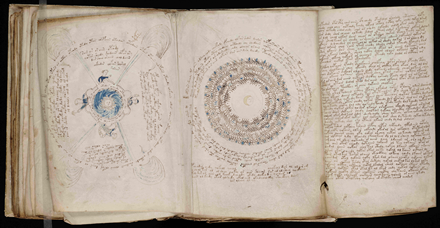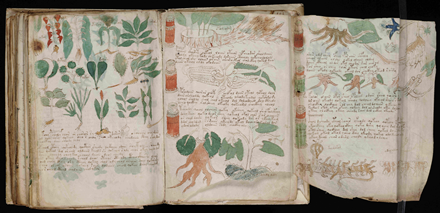 The Voynich Manuscript is an elaborately illustrated folio of 240 vellum pages hand-written by person or persons unknown in a language or code that is also unknown. People, including professional codebreakers from both World Wars, have been trying to crack it for a hundred years, ever since it was discovered outside of Rome by antique book dealer Wilfrid Voynich in a chest of books the Jesuits were trying to sell in 1912.
The Voynich Manuscript is an elaborately illustrated folio of 240 vellum pages hand-written by person or persons unknown in a language or code that is also unknown. People, including professional codebreakers from both World Wars, have been trying to crack it for a hundred years, ever since it was discovered outside of Rome by antique book dealer Wilfrid Voynich in a chest of books the Jesuits were trying to sell in 1912.
Ensourceled by the mysterious glyphs and the cosmological, botanical, pharmaceutical, culinary and biological drawings accompanying them, Voynich would spend the last 18 years of his life trying to decipher the manuscript. We are sadly no closer now than he was when it drove him to his death, but thanks to researchers from the University of Arizona physics department and radiocarbon dating, we can at least confirm that the parchment dates to the early 15th century, between 1404 and 1438, a century or so earlier than was previously thought.
They weren’t able to date the ink, however.
“It would be great if we could directly radiocarbon date the inks, but it is actually really difficult to do. First, they are on a surface only in trace amounts” [UA assistant physics professor Greg] Hodgins said. “The carbon content is usually extremely low. Moreover, sampling ink free of carbon from the parchment on which it sits is currently beyond our abilities. Finally, some inks are not carbon based, but are derived from ground minerals. They’re inorganic, so they don’t contain any carbon.”
“It was found that the colors are consistent with the Renaissance palette – the colors that were available at the time. But it doesn’t really tell us one way or the other, there is nothing suspicious there.”
Yale’s Beinecke Rare Book and Manuscript Library, current owner of the manucript, still lists the later date on its Voynich Manuscript page. The later estimate was derived from analyzing the hairstyles, clothing and castles depicted in the drawings, and it’s certainly possible that the vellum is older than the print.
The history of the volume can be traced back to 1639. At that time it belonged to Georg Baresch, a Prague alchemist who also couldn’t read it. He sent a copy of the mysterious glyphs to Athanasius Kircher, a Jesuit scholar who was an expert in obscure languages, who was stumped and intrigued. He tried to buy the book from Baresch who wouldn’t sell. After Baresch’s death, however, the manuscript went to his friend Jan Marek Marci and Marci sent the book to Kircher who was a long-time friend and colleague. When Voynich found it 250 years later, the 1665 letter from Marci to Kircher was still with the manuscript.
If you’d like to try your cryptographic hand at translating the 170,000 glyphs, separated by narrow gaps and clustered into “words” with larger gaps between them, or if you, like me, just like really pretty pictures, there’s a phenomenal gallery of every page in super high resolution here.

